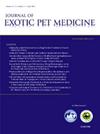Human chorionic gonadotropin treatment of bilateral nonpruritic alopecia in seven female guinea pigs
IF 0.6
4区 农林科学
Q4 VETERINARY SCIENCES
引用次数: 0
Abstract
Background: Follicular cysts are often associated with bilateral nonpruritic alopecia in guinea pigs (GPs). Hormonal therapy is a potential alternative to ovariectomy or ovariohysterectomy (OHE), but there is a lack of studies in this area. The primary aim of this prospective case series was to examine the effect and potential side effects of treatment with human chorionic gonadotropin (hCG) in GPs with bilateral nonpruritic alopecia suspected to be caused by follicular cysts. Secondary aims were to describe the frequency of associated clinical signs and to investigate if treatment with hCG would change the size of the ovary, including any ovarian cysts, identified on serial transabdominal ultrasound.
Methods: Seven pet female GPs with bilateral nonpruritic alopecia were included in the study. The GPs were treated with 100 IU/kg hCG subcutaneously once weekly for 3 weeks and monitored with clinical examinations, photographs, and ultrasonography for 8 weeks. Clinical resolution was defined as partial or full recovery from alopecia.
Results: All GPs had clinical resolution. One GP had a possible mild adverse reaction with injection site soreness. Treatment did not change the overall size of the ovaries or the ovarian cysts identified on transabdominal ultrasound.
Conclusions and Case Relevance: Treatment with hCG can be an alternative to OHE in GPs with bilateral nonpruritic alopecia consistent with follicular cysts. Long-term studies on larger populations are needed for more robust conclusions.
人绒毛膜促性腺激素治疗双侧非瘙痒性脱发7只雌性豚鼠
背景:在豚鼠(GPs)中,卵泡囊肿通常与双侧非瘙痒性脱发有关。激素治疗是卵巢切除术或卵巢子宫切除术(OHE)的潜在替代方案,但缺乏这方面的研究。本前瞻性病例系列的主要目的是检查人绒毛膜促性腺激素(hCG)治疗怀疑由卵泡囊肿引起的双侧非瘙痒性脱发的全科医生的效果和潜在副作用。次要目的是描述相关临床症状的频率,并调查hCG治疗是否会改变卵巢的大小,包括经连续经腹超声发现的卵巢囊肿。方法:选取7例双侧非瘙痒性脱发的宠物女全科医生作为研究对象。对全科医生进行100 IU/kg hCG皮下注射,每周1次,连续3周,并通过临床检查、照片和超声检查监测8周。临床消退定义为脱发部分或完全恢复。结果:所有全科医生均有临床缓解。一名GP可能有轻微的不良反应,注射部位疼痛。治疗没有改变卵巢的总体大小或经腹部超声检查发现的卵巢囊肿。结论和病例相关性:hCG治疗可作为全科医生双侧非瘙痒性脱发伴毛囊囊肿的替代方案。需要对更大的人群进行长期研究才能得出更可靠的结论。
本文章由计算机程序翻译,如有差异,请以英文原文为准。
求助全文
约1分钟内获得全文
求助全文
来源期刊

Journal of Exotic Pet Medicine
农林科学-兽医学
CiteScore
1.20
自引率
0.00%
发文量
65
审稿时长
60 days
期刊介绍:
The Journal of Exotic Pet Medicine provides clinicians with a convenient, comprehensive, "must have" resource to enhance and elevate their expertise with exotic pet medicine. Each issue contains wide ranging peer-reviewed articles that cover many of the current and novel topics important to clinicians caring for exotic pets. Diagnostic challenges, consensus articles and selected review articles are also included to help keep veterinarians up to date on issues affecting their practice. In addition, the Journal of Exotic Pet Medicine serves as the official publication of both the Association of Exotic Mammal Veterinarians (AEMV) and the European Association of Avian Veterinarians (EAAV). The Journal of Exotic Pet Medicine is the most complete resource for practitioners who treat exotic pets.
 求助内容:
求助内容: 应助结果提醒方式:
应助结果提醒方式:


